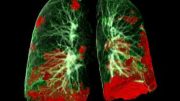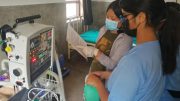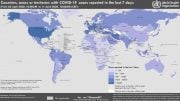
Intensivists caution against the use of premature novel therapies in lieu of traditional critical care principles in patients with COVID-19 in a recent correspondence letter in the American Journal of Respiratory Cell and Molecular Biology.
In “A Call for Rational Intensive Care in the Era of COVID-19”, Benjamin Singer, MD, Assistant Professor of Medicine and Biochemistry & Molecular Genetics, Division of Pulmonary and Critical Care Medicine, Department of Medicine, at Northwestern University Feinberg School of Medicine, and co-authors write that “the intensive care unit is already optimized for the care of COVID-19 patients and that departures from standard of care require evidence…”
The COVID-19 pandemic is unprecedented, resulting in a surge of critically ill patients that have tested the resources of medical centers around the country. The overwhelming patient demand and dwindling resources combined to trigger a cascade of emotions, stress, and fatigue. As hospital staff mobilize to meet the growing demand of COVID-19 patients, some clinicians are making note of a pattern that has emerged where proven interventions are neglected or even rejected.

Intensivists caution against novel therapies in lieu of traditional critical care principles. Credit: ATS
Dr. Singer, who is also associate editor of the American Journal of Respiratory Cell and Molecular Biology, argues that this is not the time to abandon reason. Instead, he calls for “a rational approach to translating science to the bedside as we care for patients with severe COVID-19. We want to come out of the COVID-19 pandemic knowing what works and what doesn’t work for severe viral pneumonia patients.”
He added that physicians continuously learn from their patients by making observations and so far what they’ve learned is that the most effective treatment for COVID-19 patients is supportive therapy. Until there are clinical trials that offer clear direction on a different treatment approach, state-of-the-art supportive care is the best option.
“Off-label and off-study use of novel or repurposed therapeutics prevents potential benefits or harms from being clearly defined and puts some of our most vulnerable people at risk,” cautioned Dr. Singer.
Reference: “A Call for Rational Intensive Care in the Era of COVID-19” by Benjamin D. Singer, MD; Manu Jain, MD; G.R. Scott Budinger, MD and Richard G. Wunderink, MD, 21 April 2020, American Journal of Respiratory Cell and Molecular Biology.
DOI: 10.1165/rcmb.2020-0151LE









Would Convalescent Plasma therapy, first used in the 1890’s during a diphtheria outbreak, and later in 1920 to treat sufferers of the Spanish Flu. There are several examples of the use of CBP for the prophylaxis or treatment of bacterial infectious diseases such as scarlet fever in the 1920–40s and pertussis until the 1970s. In the following decades, possible therapeutic efficacy was claimed for the management of measles, Argentine haemorrhagic fever, influenza, chickenpox, infections by cytomegalovirus, parvovirus B19 and, more recently, Middle East respiratory syndrome coronavirus (MERS-CoV), H1N1 and H5N1 avian flu, and severe acute respiratory infections (SARI) viruses Furthermore, animal models of influenza pneumonia have shown the benefit of CS (protection against H1 and H3 challenge), equine hyperimmune F(ab’)2 globulin (protection against H5N1 challenge), and monoclonal antibodies (against H1, H3, and H5N1 challenge. Interestingly, hospitalised patients with Lassa fever were also reported to have an apparently better outcome after CP administration. Furthermore, a meta-analysis on Spanish influenza-CBP (involving 8 suitable studies for a total of 1,703 patients)showed a significantly reduced mortality risk in the treated patients and suggested that CBP could be evaluated in the treatment of H5N1-related diseases. See whole article at:” https://www.ncbi.nlm.nih.gov/pmc/articles/PMC4781783/ ”
During our current pandemic, in one study, Chinese doctors cured 5 ventilatored patients (with perhaps a maximum 40% chance of living) completely. With all this positive history, I cannot understand why the method is not currently being used, with it’s side effects minimal to none, while testing of hydroxychloroquine, with some side effects untolerated by critically ill patients, continues, and remdesivir, also with harsh side effects, is being tested as a cure, while a largely effective method, with little to no side effects is still being tested and not put into production, at the very least, to cure critically ill COVID-19 patients NOW, and continue the testing if necessary as people are getting cured. Is this happening because there are no huge sums of money to be made by using a method that needs little or no drugs to support it, even if it is successful, while recovered patients are waiting to give their blood to save others, and this working method is being held back for testing when it could be in use, saving lives, and has just again proven it’s efficacy just weeks ago, in China? Something is wrong with this picture!